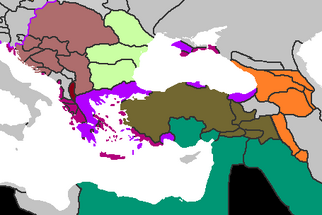
The new flag of the ESR
The History[]
In 1945, just after WWII, the two superpowers, the USSR and the USA, become embroiled in a cold war that lasted until the early 2000s. The first major event was in the 1950's, when multiple Communist nations in Asia agreed to join the USSR, to create the new ESR (Eurasian Socialist Republic). Despite repeated inventions by the United States, much of rest of Asia also agreed to join their new, powerful neighbor out of fear.[]
As the new ESR continued to expand, America was continuing to shrink. Civil unrest, anti-war sentiments and corruption.

Flag of the UFW
n continued to weaken the nation. However, there was still hope for the free world, because Europe had remained largely anti-Soviet. In response to the growing power of the ESR, America, Canada, France, Great Britain, Spain, and Mexico created the UFW (Union of the Free World), with headquarters in New York City.
It seemed that the two powers, the ESR and the UFW, were at a stalemate. The ESR controlled much of Asia and the Middle East, and the UFW occupied Western Europe and North America. The rest of the world was fair game, and the largest battleground was Africa, whose rich natural resources could be a game-changer for whoever controlled them. The first major African advance came from the ESR in the year 1956, when they tried to take control of Madagascar and the South African area. This didn't last long, however, because constant rebellions and revolutions forced the ESR to retreat entirely after only two years. However, this was enough to scare the UFW into action. After pressuring much of Western Africa to join the UFW, a successful military campaign took control of the rest of North Africa for the UFW in 1960. It seemed as though the Soviets would be losing their chance to take Africa, so they turned elsewhere, allowing the UFW to further strengthen their position in Africa. Southern Africa remained free as the Free Republic of Africa (FRA). They retained close ties to the UFW.
The ESR began to look to South America as a potential target, and such a close-to-home threat might scare the UFW into action. This campaign was much more successful, lasting from 1962 to 1965, and allowed the ESR to take control much of South Africa. Alarmed by this, the Mexican representatives of the UFW urged action to be taken. Although the other members agreed, they thought that securing control over Africa was the more pressing matter. Talks began in 1970 of the FRA joining the UFW entirely, but the ESR intervened and tried to scare them into joining the ESR by placing nuclear missiles at the border.
Scared by this threat and disappointed at the inability of the UFW to stop ESR advances in South America, The FRA joined the ESR to create the new USS (United Soviet States) in 1973. This was a major loss for the UFW, and a major victory for the new USS. The world seemed split between the UFW in the North and the USS in the South and East. However, an ambitious general named Vladimir Akintor in the USS military sought to change that. Under the auspices of the Soviet government, he launched a massive, surprise assault on Eastern Europe in 1975, taking land in Turkey, Greece, and the Balkans. This scared the European members of the UFW so much that they built a wall from the Czech Republic to Germany to try and halt the advances. It seemed as though the Soviets were on their way to victory will the recent success. Akintor continued to advances, however, into North Africa, making him the first Soviet to capture part of Africa by military means. This invoked a response from the UFW, who sent personnel, drones, and bombs into North Africa in an attempt to reclaim it. This was partially successful, with the lines being drawn about half-and-half in the year 1977.

Land taken by Akintor, with different colors representing different wars
For the first time, the USS was beginning to wholly overtake the UFW in terms of military might as well as economic strength. Recent victories had boosted investor and consumer confidence in the USS, and new land acquisitions caused agricultural output to soar, lowering food costs. In the UFW, however, food prices were on the rise, poverty was common, and there was a 10% unemployment rate. It seemed that the conflict would end soon, especially as small independent states such as The Guam Republic or The Falklands joined the Soviets. By 1980, the situation was dire. Food prices continued to sore, defeat after defeat lowered the morale of UFW military, and the credit rating had been reduced to a CCC. It seemed hopeless. The Soviet pressure continued, until the tipping point finally came, and Mexico unanimously voted to join the USS in 1985. Soon, European countries followed suit, until it was just the small American-Canadian Union (ACU) and the Canadian Alliance left. The Canadian Alliance held Alaska and most of Northern North America, and the ACU held land around the Great Lakes and the East Coast. The Soviets had extended their control over California, Texas, Nevada, and Oklahoma. The ACU and Canadian Alliance were still relatively safe, however, because they still possessed nuclear weapons.

Flag of the ACU
By 1990, even these unions had disintegrated into warring states after food shortages and corruption led to revolutions and revolts. Each state wanted to control the nukes, and therefore be safe from the Soviets. Religion was mostly gone from the region and had been replaced by mysterious, anti-Soviet cults as well as cults which worshiped the nuclear devices as divine protectors. Over the next ten years, the Soviets would continue to inch their way into the region, producing a world superstate which was named the United Socialist States of Earth, commonly called the Fourth Reich.
